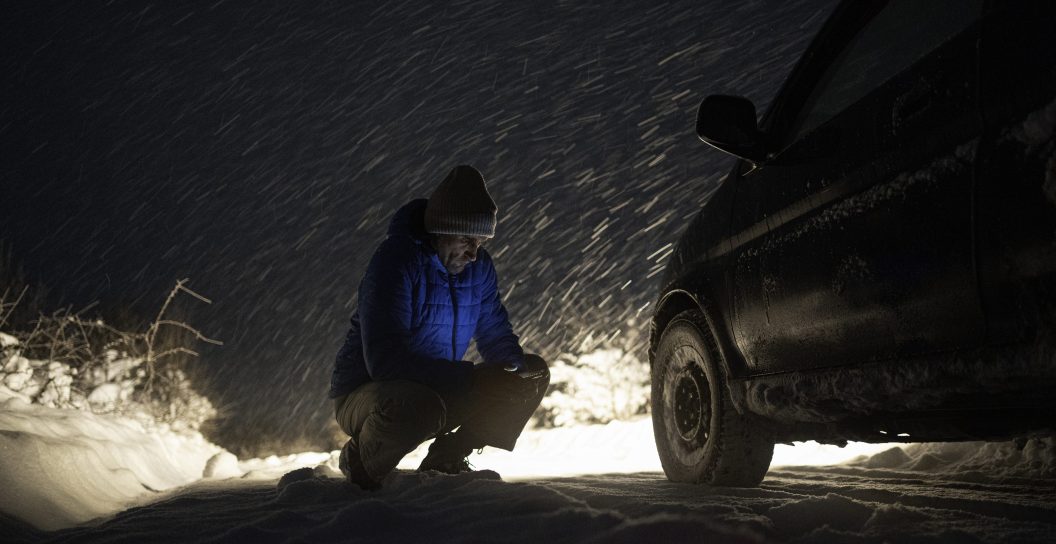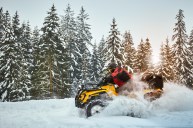Snowy weather may look beautiful from indoors behind a thick window pane, but venturing out to drive in winter can be quite another matter. Wintertime road conditions can be dangerous, with cold temperatures, black ice, and drifting snow to contend with. In addition to regular car maintenance, you'll want to put together a winter emergency car kit. This is especially important if you have any winter road trips planned or live in a remote area that's neglected by plows.
I should know: I've spent five winters in Alaska, driving all sorts of vehicles in all sorts of conditions in very remote areas. Alaska isn't exactly famous for its quality roads, either, and plow trucks can be few and far between. After getting hopelessly stuck in a few trailhead parking lots, either because of snow, dead batteries, or flat tires, I learned to keep a well-stocked emergency car kit in my vehicle at all times and taught myself some basic car repairs, like changing my tires, jumping my battery, replacing my wiper blades, and changing my headlight bulbs.
Emergency car kits are essential for any season, but there are a few winter-specific survival items that you'll need. Don't leave home without these must-have tools for winter car emergency kits.
What to Pack in a Winter Roadside Emergency Kit
Now, it's time to build your winter emergency roadside kit. While this may seem like an exhaustive list, I would posit that all of these items are necessary for auto safety when driving in the winter.
Snow and Ice Car Tools
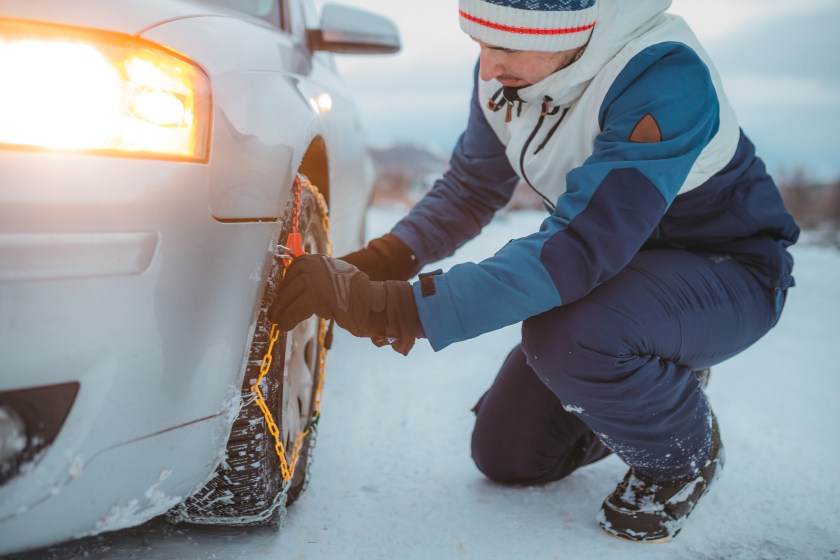
Getty Images, Coppy
Snow scraper: If you live somewhere that sees snow or ice in the winter, this probably already lives in your car. Snow scrapers are a vital tool in the winter to clear snow off your roof and ice from your windshield. The best scrapers are extendable, letting you reach even the tallest trucks. I like the Moyidea Extendable Ice Scraper; it breaks down into a tiny carry sack so that you can leave it in your car all year round.
Snow shovel: If you get stuck in deep snow, chances are you will need a shovel to help unbury your tires. I keep an avalanche shovel in the back of my truck. It's small and collapsable, and the metal blade is incredibly strong. Plus, when I head out into the backcountry I can just slip it into my pack.
Cat litter (or sand): It's not just for cats! If you're stuck in the snow or on ice and your tires can't get traction, throwing some cat litter or sand in front of them may help them get the grip they need.
Tire chains: If you drive in mountainous terrain, you should keep a set of snow chains in your vehicle; they're mandatory in some states for non-4WD vehicles on many mountain passes. Chains give you incredible traction but should only be used when the roads are covered in ice or snow. I've also thrown them on while stuck in a snowy parking lot to help me get back to bare pavement. You only need two—for the front axle for front-wheel drive, or the rear axle for rear-wheel drive—and they must be sized correctly for your tire size. Practice putting them on before you actually need them.
Tow strap: If shoveling, cat litter, and tire chains aren't enough to get you unstuck, you may need some additional assistance. When I first moved to Alaska, I drove a Subaru Impreza that was constantly getting stuck in unplowed parking lots. Luckily, people were more than willing to give me a quick tow to shallower snow. Now, I always keep a small tow strap in my vehicle so that I can either get a tow or, now that I have a truck, lend a hand to someone else.
Car Tools to Get You Back on the Road
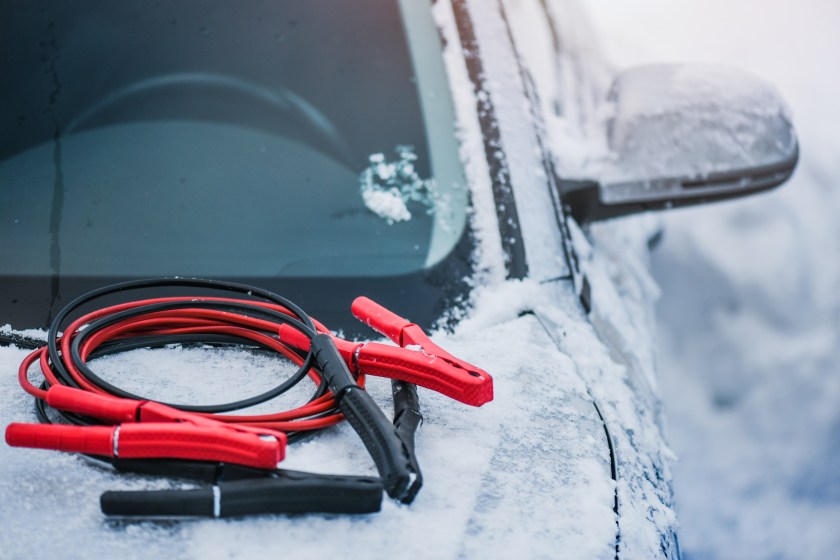
Getty Images, Milan Krasula
Jumper cables: Car batteries die a lot quicker in colder weather, which is why you should always carry jumper cables or a self-contained jump starter. When I lived in Fairbanks, Alaska, temperatures would get well below -20 Fahrenheit several times a winter. I had a block heater for my battery, but if I was somewhere I couldn't plug it in, I'd occasionally come outside to a cold, dead car. I like carrying a power bank jump starter because I'm often in places where there aren't other people to rely on for a jump. Double-check that it's charged before a trip.
Fire extinguisher: If a fire breaks out in your car's interior or under the hood, it can quickly get out of control if you don't have a fire extinguisher handy. A fire extinguisher should live in your vehicle, no matter the season. Your car fire extinguisher should be rated for A, B, C, and K fires, like the Element E50 fire extinguisher. Make sure you know how to use it and that it's not expired.
Spare tire and jack: These should be in your car no matter the season. Ensure that your spare tire is properly inflated; there's nothing quite as frustrating as finding a flat spare tire when trying to change a flat main tire. You'll also need a wheel wrench and a jack, and know how to use them.
Tire repair kit and air compressor: Sometimes, changing a flat isn't possible or necessary. Tire repair kits and tire sealants let you plug up small holes easily without having to take the tire off. After plugging the tire, you'll need an air compressor or tire inflator to fill it back to the recommended PSI. Some tools combine compressors and power bank jump starters, like the Stanley Portable Power Station Jump Starter. Most come with tire pressure gauges.
Windshield washer fluid: With snow falling from the sky and getting kicked up from the road, you'll need plenty of windshield washer fluid to keep your windshields clean and free of frost. I always carry extra in the winter, because I go through it quicker than I expect. Get some with a de-icing formula to help melt ice and eliminate refreezing, like the Rain-X -30 Degree De-Icer Windshield Washer Fluid.
Basic tool kit: This should include screwdrivers, pliers, wrenches (Allen, spanner, and socket), and pliers, at the minimum. These tools will be vital for performing small, basic maintenance on the road, like changing out headlights. My favorite kit is the Apollo 56 Piece Auto Tool Set; it comes with everything you need in a small, zippered case.
Duct tape, bungee cords, and cable ties: When all else fails, there's not much you can't accomplish as a temporary fix with some duct tape, bungee cords, cable ties, and ingenuity. My dad once fixed his exhaust with nothing more than a can of cat food and some duct tape. Duct tape, bungee cords, and cable ties may help you jerry-rig a repair together until you get home or to a shop.
Gear to Keep You Warm and Safe
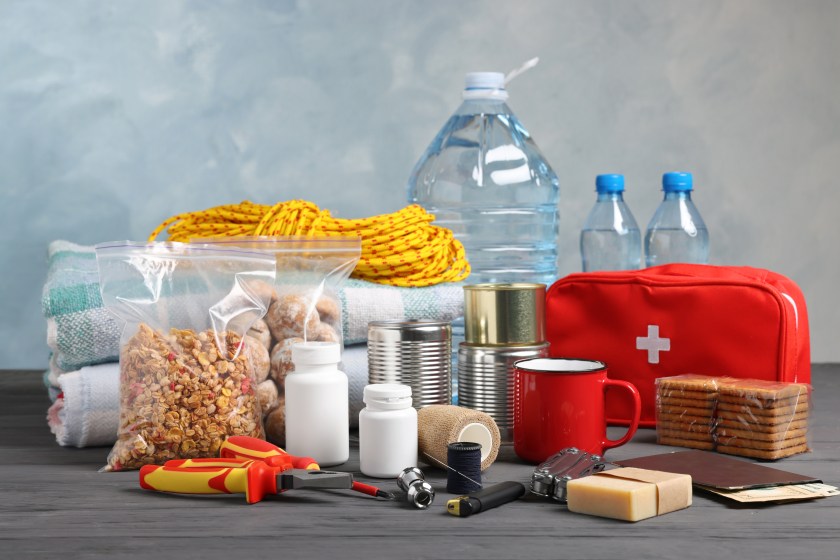
Getty Images, Liudmila Chernetska
Warm clothes and a sleeping bag: Cold temperatures can turn even a simple tire change into a survival situation in the winter. Make sure you keep plenty of warm clothes, including boots, hats, and gloves, in your car at all times in the winter. If I'm going on a long or remote drive, I also put my winter sleeping bag or an emergency blanket in my car in case I get stuck overnight.
Food and water: Everything takes more time in the winter, including car maintenance and, if you need it, rescue or roadside assistance, like AAA. If you get your car stuck or it breaks down somewhere that's difficult to access, you could be there for a while. Keep plenty of water and non-perishable, calorie-rich foods like nuts and protein bars in your car to keep you fueled.
First aid kit: A first aid kit, like the NOLS Med Kit 5.0, lives in my car no matter the season. Basic first aid supplies allow me to deal with unexpected injuries or accidents immediately, rather than waiting for first responders or until I can get to a store with medical supplies. You may also consider taking a Wilderness First Aid or Wilderness First Responder course so you know how to use your first aid kit to the fullest effect.
Cell phone charger: Unless you have a satellite messenger device in your car, your cell phone is your only way to communicate with the outside world. Keep a charging cord and a battery bank in your car can keep you connected (and is useful if that sat phone has also run out of batteries). I like the Anker PowerCore 1000 Portable Charger. Just remember, batteries drain quicker in the cold, so stash your cell phone and battery bank in a pocket on your body to keep them warm.
Headlamp and batteries: Nightfall comes quickly in the wintertime and if your car battery is dead or your front end is stuck in a snowbank, you may not be able to rely on your car's lights to see. Make sure you keep a quality headlamp and extra batteries in your glove box. A headlamp will let you keep your hands free if you have to do any fiddly work with your toolkit or shovel out your car after dark.
Reflective safety gear: If you're stuck on the side of the road, and especially if you're outside of your vehicle trying to dig it out or fix it, you need to make sure you're easily seen by other motorists. Numerous accidents and deaths happen every year from other drivers running into vehicles or people they didn't see on the side of the road. Your emergency kit should have reflective triangles, flares, and a reflective vest for yourself. Deploy all of these tools if you need to spend time outside of your car.
A good attitude: Breaking down or getting stuck in the snow is never fun. But like most emergencies, one of the best things you can keep in your winter survival kit is a good attitude. Keeping a good, positive outlook will help you think critically and creatively to get yourself out of any wintry fix.
Why Do I Need a Winter Car Emergency Kit?
Your ability to deal with emergencies comes down to one thing: your emergency preparedness. This is just as true on city streets as it is in the backcountry, and it's doubly true in the winter. While an auto emergency in the summer may mean a few hot hours waiting for roadside assistance to show up, in the winter it could easily turn into a survival situation. With tough driving conditions and increased calls for help, rescue or roadside assistance may be slow to respond in winter. An emergency car kit—and the knowledge of how to use it—enables you to deal with many automotive issues yourself, from getting stuck in the snow to getting a flat tire. At the very least, it can keep you calm and comfortable until more help arrives.
When Should I Have a Winter Emergency Kit in My Car?
I'm a proponent of always keeping an emergency kit in my car, no matter the season or the weather. Being able to fix my own tire or headlight, add washer fluid, or dig my car out of the snow gets me back on the road quicker and has saved me from countless hours waiting for roadside assistance.
You should at least keep a winter emergency kit in your car anytime you're driving somewhere new or on a longer road trip, or driving into or near the mountains where the weather can turn unexpectedly harsh or when you know there is a storm coming.
